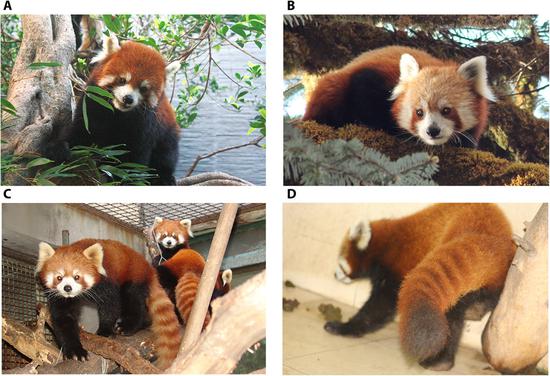Study reveals red panda may be two distinct species

(A and C) The Chinese red panda. (B and D) The Himalayan red panda. (A and B) The face coat color of the Chinese red panda is redder with less white on it than that of the Himalayan red panda. (C and D) The tail rings of the Chinese red panda are more distinct than those of the Himalayan red panda, with the dark rings being darker red and the pale rings being more whitish. (Photo from the research article)
Genome sequencing has shown that red panda, the endangered furry mammal native to the eastern Himalayas and southwestern China, are two different species, providing a theoretical basis for more targeted conservation efforts.
Scientists previously divided red pandas into two subspecies with the Nujiang River in southwest China's Yunnan Province as the geological boundary. Those to the east of the river were classified as the Chinese red panda, and those to the west were the Himalayan red panda. But the classification has long been debated.
In the latest study, researchers from the Institute of Zoology under the Chinese Academy of Sciences did whole-genome sequencing on 69 red pandas. They also analyzed 49 red panda's mitochondrial DNA, which is inherited only from the mother, and the Y chromosome sequencing from 49 male red pandas.
The researchers reported in the online version of Science Advances that red pandas, based on the analysis results, fall into two genetic clusters, and the two clusters are distinct enough to be classified as two distinct species.
They said the division line between the two species should be the Yarlung Zangbo River, and the divergence of the Himalayan red panda and the Chinese red panda occurred about 220,000 years ago.
Genetic analysis also showed that the Chinese red panda experienced two population bottlenecks, and the Himalayan had three. A population bottleneck refers to a sharp reduction in the size of a population due to environmental causes.
The researchers said their study is of great significance for conservation.
The Himalayan red pandas were found to carry more potentially harmful genetic mutations, and their genetic diversity is low, which means the species suffer a higher risk of population decline in the face of diseases or harsh climate change.
They noted that conservation measures should be more targeted in the future. Interbreeding between the two species in captivity is possibly detrimental and should be avoided.
The red panda is listed as Endangered on the International Union for Conservation of Nature Red List with less than 10,000 estimated to remain in the wild.
